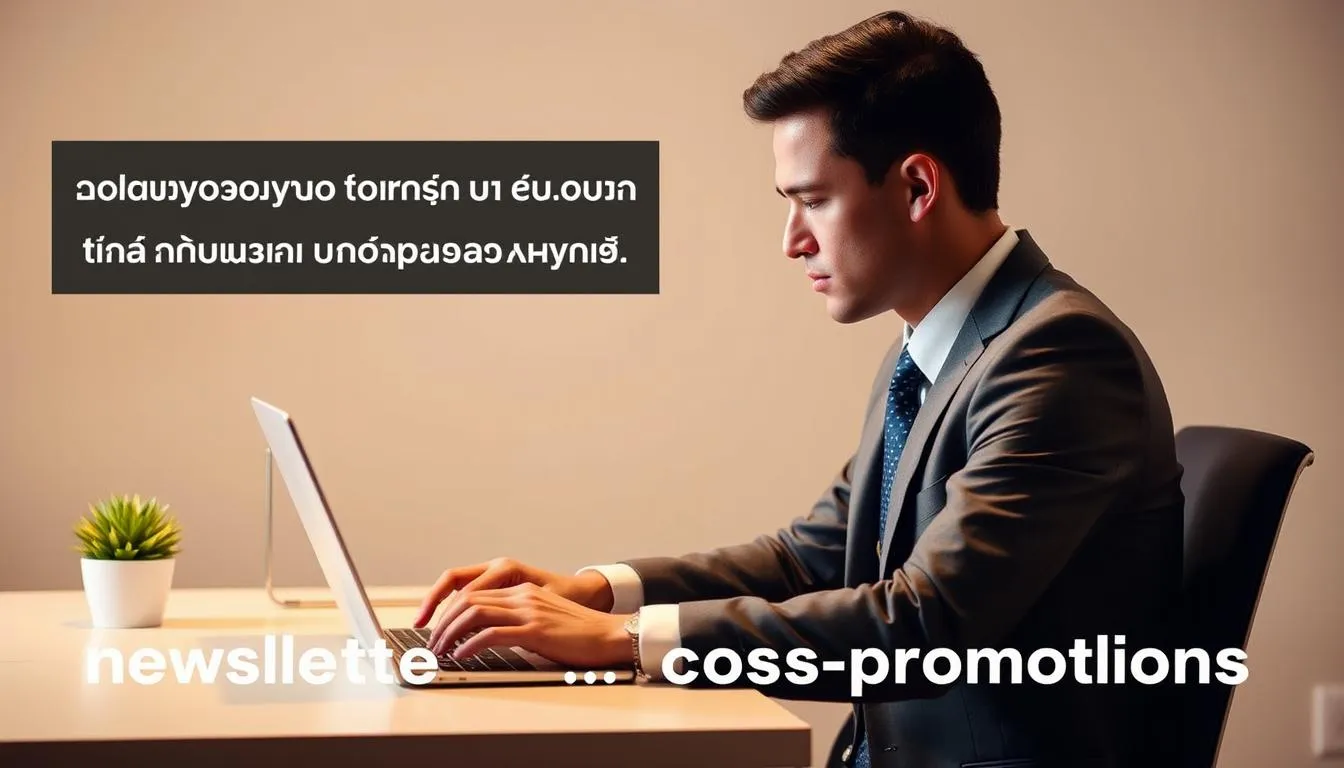Surprising fact: some creator swaps have driven thousands of sign-ups in a single week, turning small lists into major growth engines overnight.
This piece shows how a strategic cross-promotion strategy aligns two creators so each introduces their audience to a trusted, relevant newsletter. When done right, you leverage another creator’s trust to earn high-intent email subscribers without paid spend.
People prefer curated recommendations from voices they follow, not generic ads. That is why relationship-led collaborations, like when Codie Sanchez used partner-provided talking points with Ali Abdaal and Noah Kagan, keep message quality high and deliver steady growth.
This introduction previews a practical system: how to evaluate fit, prepare your content and newsletter, find the right people, and execute swaps that respect both brands. To enhance your email marketing strategy, consider implementing lead generation techniques with strategic freebies. You’ll get templates, checklists, and measurement tactics to maximize value from each email exchange.
Key Takeaways
- Aligned partnerships multiply reach without ad spend.
- Quality subscribers beat vanity metrics for long-term growth.
- Use clear positioning so your message resonates with the right audience.
- Prepare shared talking points to maintain consistent content and voice.
- Follow a relationship-led strategy, not mass outreach, for best results.
- Learn a repeatable swap system and measurement tactics to scale.
- See an actionable guide on how to grow your list with partner swaps at 6 ways to grow your email.
Why cross-promotions still work in 2025 for growing quality email audiences
Direct recommendations still cut through the noise in 2025, giving creators a practical way to gain relevant email subscribers fast.
Search intent fit: people are looking for an actionable way to reach new, relevant subscribers without wasted budget. This method answers that need by introducing your offering to an adjacent audience that already trusts the recommender.
Effective collaborations prioritize aligned content and mutual recommendation. When both parties agree on placement and timing, sign-ups convert into engaged readers faster.
“Optimizing for quality partners preserves audience trust and yields better long-term results than chasing raw reach.” — Observed across creator case studies (Codie Sanchez, Ali Abdaal, Noah Kagan)
Quality over quantity: protect your brand by choosing partners whose people face similar problems your content solves. Learn how to structure long-lasting content that attracts quality subscribers through evergreen content strategies. That leads to higher opens, clicks, and retention—real results worth tracking.
- Meets search intent: a clear way to grow without ads.
- Shortens time to first open by relying on trust.
- Delivers sustained engagement when positioning is tight.

| Metric | Raw Reach | Aligned Reach |
|---|---|---|
| Typical sign-ups | High volume, low relevance | Moderate volume, higher conversion |
| Post-signup engagement | Low opens and retention | Higher opens and sustained clicks |
| Brand impact | Risk of trust erosion | Credibility transfer, brand boost |
Prep work: Make sure your newsletter is ready before partnering
Before you trade audience access, confirm your newsletter delivers a clear, repeatable promise to new readers. Define your target audience and write a concise “why subscribe” blurb that another person can say in one line.
Make sure your content cadence and quality are consistent. New subscribers should see top work in the first week. Budget time to refresh your welcome sequence and highlight your best issues. For guidance on building strong membership communities around your newsletter, explore our membership community building ideas.
 Validate readiness with signals: organic replies like “I loved this!”, steady link clicks, and unprompted shares. These show real engagement and prove your brand positioning resonates.
Validate readiness with signals: organic replies like “I loved this!”, steady link clicks, and unprompted shares. These show real engagement and prove your brand positioning resonates.
Practical items to prepare
- Short swipe copy in short, medium, and sponsor-slot lengths so partners can feature you cleanly.
- A lightweight one-pager with value proposition, recent issues, social proof, and the specific people you serve.
- Clear strategy notes: preferred placement, timeline, and any dates that matter for marketing impact.
- If your email list is ~100+ and your positioning is dialed, you can run swaps with similarly sized peers.
Sending your first email newsletter is a helpful reference for tightening onboarding so new readers see your strongest work right away.
Where to find cross-promotions partners without spamming
Find partners where real conversations already happen—your existing DMs and comment threads are low-friction starts. Begin with creators you read, follow, or have messaged before. Familiarity raises the odds a suggested promotion will be welcomed.
Social DMs
Start small: message commenters, past collaborators, or creators whose work you share. Reference a recent issue you liked and propose a date and placement. That specific ask beats vague cold emails.
Recommendation networks
Check ConvertKit Creator Network, beehiiv Boosts, and Substack Recommendations to discover aligned newsletters ready for swaps. These platforms surface potential partners who already expect promotions.
Marketplaces, communities, and content discovery
Explore Lettergrowth and creator Slack or Discord channels, but vet every outreach—some listings act like bulk cold emails. Also repurpose newsletter issues into SEO-friendly blog posts so aligned people find you.

- Create a simple landing page for partners with audience details, typical placements, and a swap form.
- Track each potential partner in a sheet or CRM and prioritize audience fit over raw list size.
| Channel | Best for | Risk |
|---|---|---|
| DMs | Warm replies | Low |
| Networks | Curated matches | Medium |
| Marketplaces | Scale | High (spam) |
Due diligence: Evaluate lists, audiences, and fit before you say yes
Before you agree to a swap, run a quick audit that shows whether a partner’s list will actually move the needle for your email goals.
Ask for core stats: list size, average open rate, and typical click counts. Request specific cross-promo click results so you can compare partners on real performance.
Check engagement outside the inbox. Look at recent social posts, replies, and shares. Active conversations often signal healthier audiences than size alone.
- Review sponsorship one-pagers or Passionfroot profiles to see historical click benchmarks and set realistic expectations.
- Prioritize adjacent audiences where problems overlap but content angles differ—these often convert better than identical audiences.
- Verify timing and cadence: a growing, active list gives your email a better chance to be seen quickly.
“Some creators with smaller lists drive 100+ sign-ups; others with much larger, flat lists deliver few results.”
Record every interaction and metric so you can compare partners objectively and avoid repeating work that didn’t meet expectations. Use small test placements first and scale when results look good.
For a quick checklist and useful prompts for partner conversations, download the 53 diagnostic questions to guide your due diligence and save time.
| What to request | Why it matters | Red flag |
|---|---|---|
| Average open rate | Shows inbox engagement | Very low opens vs. list size |
| Cross-promo click counts | Predicts expected sign-ups | No historical campaign data |
| Recent posting cadence | Signals current audience attention | Long gaps between issues |
How to execute niche newsletters cross-promotion the right way
A clear execution plan turns a friendly mention into measurable subscriber growth.
Start with swipe copy in three lengths: a one-liner, a 2–3 sentence blurb, and a sponsor-slot paragraph that anchors your value. Keep each version punchy: hook, problem you solve, and a call-to-action to a tracking-enabled landing page.
Placement and partner assets
Feature sections and intros usually outperform buried lines. Provide a short bio, logo, headshot, and 1–2 standout pieces of content so mentions feel natural.
Make it easy and ethical
Share talking points and draft copy to reduce back-and-forth. Set timelines for draft, review, and send dates.
“Codie Sanchez used partner-provided talking points to keep message quality high and consistent.”
- Use UTM/ref links and confirm the landing page before launch.
- Offer examples of past promotions so partners can mirror tone and structure.
- Avoid irrelevant cold outreach; target partners whose readers gain real value.
| Task | Why it helps | Quick win |
|---|---|---|
| Provide 3 swipe lengths | Makes placement choices simple | Saves partner time |
| Confirm tracking links | Attributes results accurately | Faster reporting |
| Set a shared timeline | Reduces last-minute edits | Better launch quality |
Tracking and measuring results so you can repeat what works
A tight measurement plan lets you see which partner placements actually move the needle for your email list. Start by deciding how you will attribute sign-ups and what success looks like.
Use UTM parameters and ref tags to attribute signups
Tag every partner link with UTM or ref tags like growthinreverse.com/?ref=theirnewslettername or utm_source=theirnewsletter&utm_medium=email. This makes it clear which placement and page drove traffic.
Monitor on-site behavior and engagement post-signup
Don’t stop at sign-ups. Use Google Analytics to check time on page, scroll depth, and clicks. Then watch the first 3–5 issues for opens, clicks, and unsubscribes to judge quality.
Benchmark results to decide on repeat promotions
Keep a simple sheet: expected clicks, actual clicks, conversion rate, and downstream engagement. Pull partner click data from media kits when you can. Run a retro within 72 hours and again after two issues.
“Repeat with partners who deliver strong post-signup engagement, not just raw sign-ups.”
| Metric | Why it matters | Quick action |
|---|---|---|
| Clicks from partner | Predicts volume | Compare to sponsor page benchmarks |
| Conversion to list | Shows landing page fit | Tweak CTA and landing page |
| Post-signup engagement | Indicates long-term value | Decide cadence and repeat timing |
Log every test so you can copy the structure, timing, and copy that worked. Over time, this strategy saves time and turns one-off work into reliable growth.
Real examples, scalable systems, and relationship-led growth
Case studies reveal how consistent processes and relationship-led outreach convert audiences into loyal readers.
Creator examples: Codie Sanchez used partner-provided talking points when working with Ali Abdaal and Noah Kagan to keep message quality consistent across different audiences.
Ali Abouelatta added 465 subscribers in eight months by running focused swaps with aligned partners. That shows small list wins scale when positioning is clear.
Systemize the work
Build reusable swipe copy in three lengths, a partner tracker sheet, and a simple calendar for cadence. These tools cut friction and make repeats predictable.
Beyond swaps
Combine swaps with referral programs (Milk Road, Morning Brew saw big referral lifts), repurposed blog posts like Exec Sum for SEO, and X threads with CTAs. Nathan Baugh’s World Builders used threads plus giveaways to accelerate sign-ups.
“Repeatable systems and real relationships turn one-off promotions into lasting growth.” — Creator case study observations
Quick checklist:
- Create swipe copy and partner assets.
- Track results in a partner tracker and compare conversions.
- Test small, then scale winners into long-term partnerships.
| Example | Action | Outcome |
|---|---|---|
| Codie Sanchez + Ali Abdaal | Standardized talking points | Consistent message quality across audiences |
| Ali Abouelatta | Targeted swaps with aligned audiences | +465 subscribers in 8 months |
| Morning Brew / Milk Road | Referral programs | Significant reader growth (~33% cited for referrals) |
Conclusion
Finish strong: pick one aligned partner, one placement, and one date, then launch and measure every step.
Start with a crisp target audience and a short “why subscribe” line. Protect your brand by saying no to mismatched promotions. Use simple assets: swipe copy, a partner tracker, and UTMs on the landing page.
Pair swaps with a referral incentive, a compact product, or a repurposed blog post to boost perceived value. Track clicks to sign-ups and the first three emails to judge real subscriber quality.
Keep outreach human and relationship-led. Pick a partner, test one placement, learn fast, and repeat what works to grow your email list with confidence.
FAQ
Why do cross-promotions still work in 2025 for growing quality email audiences?
They connect you to relevant, pre-warmed readerships who already trust the sender. When you partner with publishers or creators whose values and content match yours, new subscribers arrive more likely to engage and stay. Use clear value propositions and targeted offers to keep conversions high.
How do I know my newsletter is ready before partnering?
Look for consistent engagement signals: steady open and click rates, regular replies, and shares. Have a clear target audience, a concise “why subscribe” blurb, and a tested welcome sequence. These reduce risk for partners and improve the odds of a successful swap or sponsorship.
Where can I find promotion partners without spamming?
Start with creators you already follow and interact with on social DMs. Use recommendation networks like ConvertKit Creator Network, beehiiv Boosts, and Substack Recommendations. Join communities such as Lettergrowth and niche Slack or Discord groups, and surface partners via high-performing blog posts found through SEO.
What should I check during due diligence on a potential partner?
Ask for list size, typical open rates, and click activity. Request average click counts for past promos and look at audience overlap and adjacency—adjacent audiences often expand reach more than identical ones. Confirm tone, brand fit, and any contractual terms around exclusivity or timing.
How long and what types of copy should I provide my partner?
Prepare three lengths: a short one-liner, a medium paragraph for editorial mentions, and a sponsor-slot version with benefits and a call-to-action. Include talking points, links, alt text for images, and a preferred landing page to make the partner’s job simple and fast.
Where should partner blurbs be placed in an email for best results?
Placement depends on format and audience. Intro slots work for high-trust announcements, feature sections suit curated roundups, and sponsor blocks are best for direct offers. Test placements and track which position yields the most signups for future decisions.
How do I attribute signups and measure promo performance?
Use UTM parameters, referral tags, and unique landing pages to attribute signups. Monitor on-site behavior after signup—time on page, additional signups, and replies—to judge quality. Compare to benchmarks like expected click-to-subscribe ratios to decide if a repeat makes sense.
What benchmarks should I use to judge a successful promotion?
Benchmarks vary, but track click-through rate, conversion rate to subscribers, and engagement of new subscribers in the first 30 days. Small lists can see solid wins from 100–500 targeted clicks; large lists should still be judged by quality of activity, not raw numbers alone.
Can small lists benefit from swaps, or do I need a big audience?
Small lists can win if positioning is clear and the audience is engaged. Targeted swaps with adjacent audiences often yield better conversion than broad blasts. Start with partners who share a similar reader profile, and use repeat, relationship-led promotions to scale.
What outreach approach gets the best partner responses?
Personalized outreach works best. Reference a recent piece of theirs you liked, explain mutual audience benefits, and propose a clear, low-friction exchange: exact copy, timeline, and tracking method. Avoid mass cold emails that ignore audience fit.
What systems help scale repeat promotions?
Build reusable assets: swipe copy library, a partner tracker spreadsheet, performance log, and a cadence calendar. Standardize onboarding messages and deliverables so each campaign launches quickly and consistently. Track lifetime value of subscribers acquired to refine partner selection.
What ethical considerations should I keep in mind?
Always be transparent about sponsored content and respect subscriber trust. Avoid promoting partners who contradict your brand values. Ensure opt-in clarity on landing pages and honor privacy rules and email marketing regulations.
What other channels should I combine with email swaps for better results?
Layer promotions with related blog posts, social threads on X or LinkedIn, and referral programs to amplify reach. Repurpose promo content into a short article or post to capture SEO and social attention, driving longer-term discovery beyond the initial send.
Can you give real examples of creators who successfully partner for growth?
Creators like Codie Sanchez, Ali Abdaal, and Noah Kagan have used collaborations and recommendations to expand audiences. They combine quality content, clear offers, and consistent follow-ups to convert referrals into engaged subscribers and customers.
